Adirondack Wildlife:
Birds of the Adirondacks
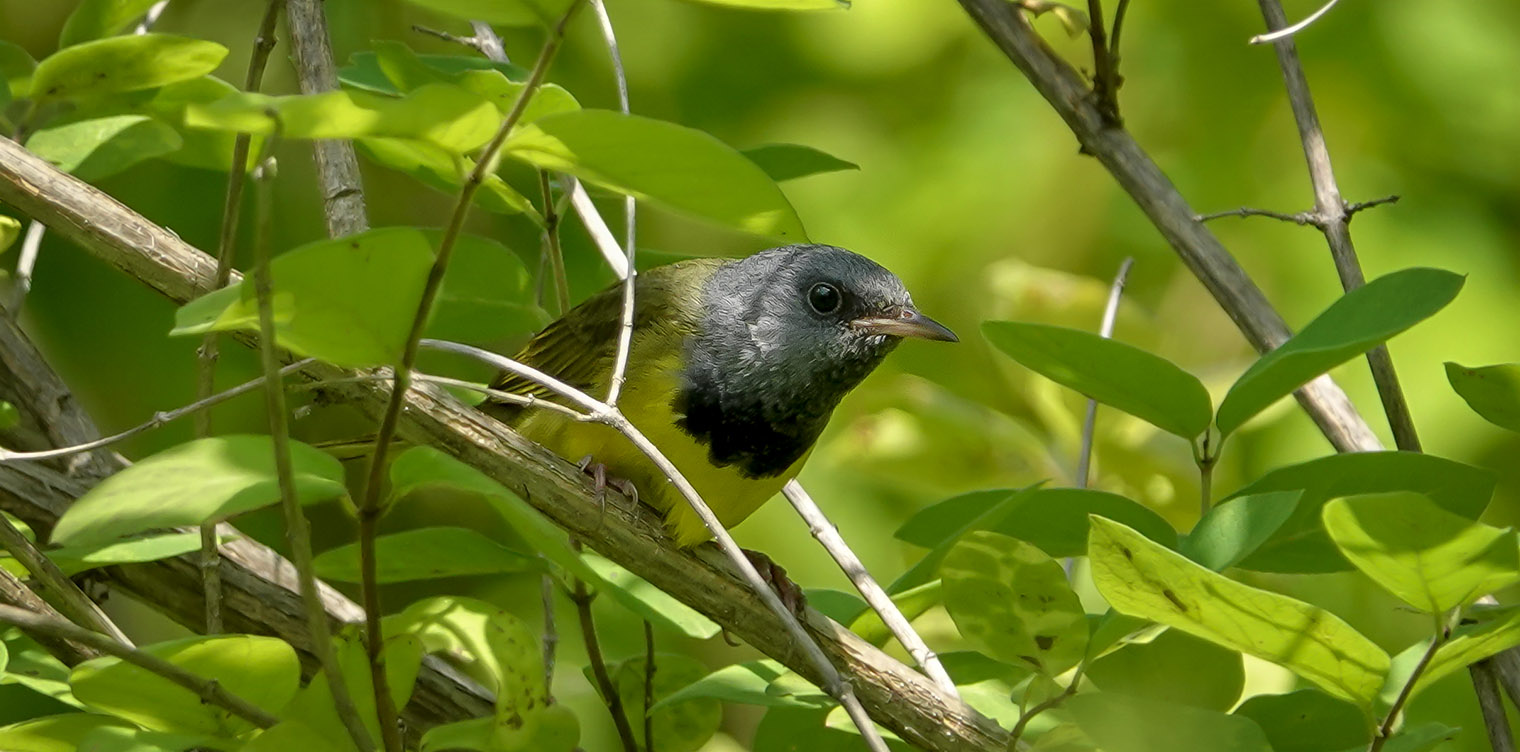
The birds we see and hear in the Adirondack Park fall into several general categories:
- Spring and Summer Residents: Birds which use the Adirondack Mountains as a breeding ground, but winter in warmer climates further south.
- Transients: Birds which breed farther north in Canada and are seen fleetingly in the spring as they migrate to their northern breeding grounds and then again in the fall when they migrate south to their winter range.
- Winter Residents: Year-round resident birds which make the Adirondacks their permanent residence and have developed strategies to survive the harsh winters, plus birds which breed farther north in Canada and migrate to our area to spend the winter.
The cast of birding characters in any location in the Adirondacks changes – sometimes gradually, sometimes abruptly – with the march of the seasons.
Birds of the Adirondacks: Spring and Summer Residents
Around April, the many bird species that spend their winters in warmer climates to the South make their way back to the Adirondack Mountains to find partners and rear a family. One of the many joys of early spring birding in the Adirondacks – in addition to the absence of deciduous foliage to impede visibility and the relative paucity of biting insects – is the pleasure of welcoming back migrants from the south. By the end of April, birders can expect to see the earliest-arriving migrants. The influx of our summer residents continues through May.
During the spring months, the birds arriving from the south are establishing territory and finding mates. The woods are vibrant with arriving birds, singing and showing off their mating display. The frenetic activity reflects the limited time that birds have to raise their young before it's time to start the journey back to the wintering range.
Spring & Summer Birds of the Adirondacks:
Warblers
- American Redstart
- Bay-breasted Warbler
- Black-and-white Warbler
- Blackburnian Warbler
- Blackpoll Warbler
- Black-throated Blue Warbler
- Black-throated Green Warbler
- Blue-winged Warbler
- Canada Warbler
- Cape May Warbler
- Cerulean Warbler
- Chestnut-sided Warbler
- Common Yellowthroat
- Golden Winged Warbler
- Hooded Warbler
- Louisiana Waterthrush
- Magnolia Warbler
- Mourning Warbler
- Nashville Warbler
- Northern Parula
- Northern Waterthrush
- Ovenbird
- Palm Warbler
- Pine Warbler
- Prairie Warbler
- Tennessee Warbler
- Wilson's Warbler
- Yellow Warbler
- Yellow-rumped Warbler
Warblers are among the most colorful and interesting of the migratory species that breed in the Adirondacks. Warblers are small songbirds that subsist mainly on insects (at least during breeding season). The warblers that breed throughout the US are wood warblers, or New World Warblers, assigned to the family Parulidae. Wood warblers are mainly foliage gleaners, with slender, pointed bills. The males are usually brightly colored, with distinctive songs they use to attract females to their breeding territories.
There are about 120 or 130 species in the wood warbler family. The Second Atlas of Breeding Birds in New York State (2008) lists 34 warblers that breed in New York State, of which 29 are listed as possible, probable, or confirmed breeding birds in the Adirondack Park. All are migratory. Most arrive in the Adirondack Mountains in late April or early May and depart in September or October.
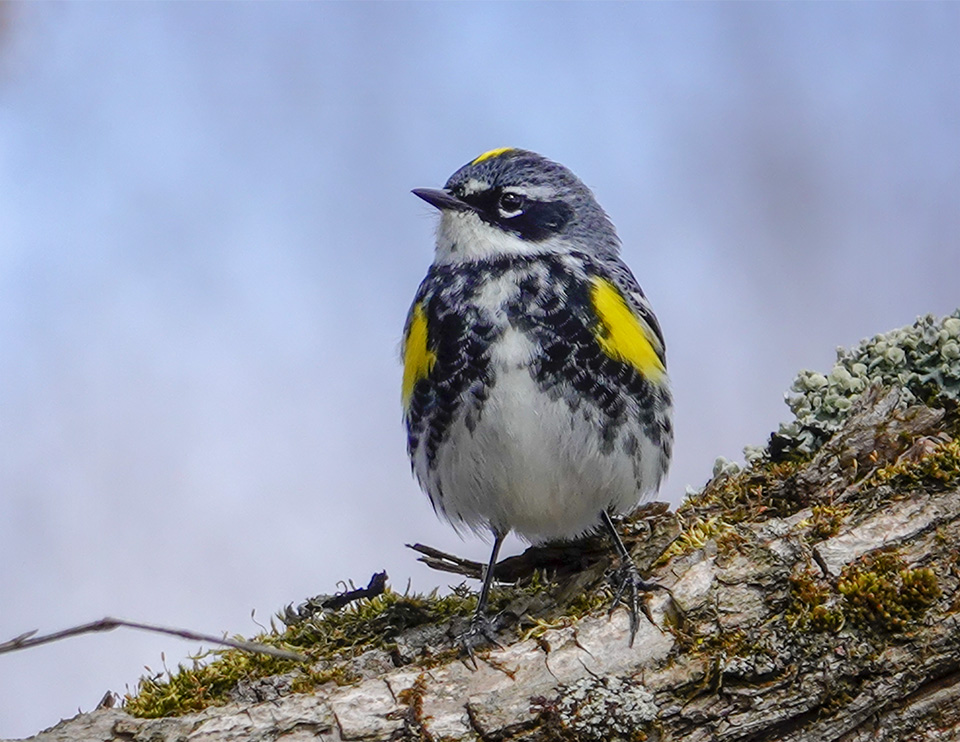
Yellow-rumped Warbler: One of the early-returning warblers is the Yellow-rumped Warbler. This warbler winters in the southern United States, Mexico, and the western Caribbean, migrating north to our part of the Adirondacks by about late April. Its whistled warble can be heard along many trails in our region. It is especially common on the edges of wetlands, such as Barnum Bog and Bloomingdale Bog. Look for Yellow-rumped Warblers perched on the outer limbs of trees or flitting through the canopies of coniferous trees as they forage.
Palm Warbler: The Palm Warbler is also among the earliest warblers to return to its familiar haunts on Adirondack bogs. This attractive, rusty-capped warbler spends the colder months in the southern US and Caribbean, and sets off for its northern breeding grounds in April. This bird is usually seen in the Adirondacks by late April. One of the most reliable places to find this bird is on Barnum Bog, which can be accessed by the boardwalk on the Boreal Life Trail. Listen for the Palm Warbler's continuous, flattened trill and watch for its bobbing tail. This species is a ground nester and forager, but is most easily seen when it perches on the top of the Black Spruce trees which flourish in Barnum Bog. You can also find Palm Warblers along the Bloomingdale Bog Trail.
Black-throated Green Warbler: The Black-throated Green Warbler uses a variety of habitats throughout its range. In much of the Adirondack region, breeding pairs are most commonly found in coniferous forests or mixed woods. Breeding male Black-throated Greens have a black chin, throat, and upper breast, contrasting with a bright yellow face and a white belly streaked with black. This warbler is a long-distance migrant, wintering in Central and northern South America and returning to the Adirondacks in late April and early May to breed. Listen for Black-throated Green Warblers singing from treetops or within vegetation, often while foraging.
Spring & Summer Birds of the Adirondacks:
Other Summer Upland Birds
- Baltimore Oriole
- Barn Swallow
- Blue-headed Vireo
- Bobolink
- Broad-winged Hawk
- Brown Thrasher
- Chimney Swift
- Chipping Sparrow
- Common Grackle
- Eastern Bluebird
- Eastern Phoebe
- Gray Catbird
- Hermit Thrush
- Indigo Bunting
- Northern Flicker
- Red-eyed Vireo
- Rose-breasted Grosbeak
- Ruby-crowned Kinglet
- Ruby-throated Hummingbird
- Savannah Sparrow
- Scarlet Tanager
- Swainson's Thrush
- Tree Swallow
- Turkey Vulture
- White-throated Sparrow
- Winter Wren
- Yellow-bellied Sapsucker
Warblers are not the only birds which make an annual trek from warmer summer climates to breed in the Adirondacks. The majority of birds we see in the Adirondack uplands in the warm months are also summer residents, most of whom arrive in large numbers in April and May to establish territories, find mates, and raise a family before the cooler weather of late summer and fall.
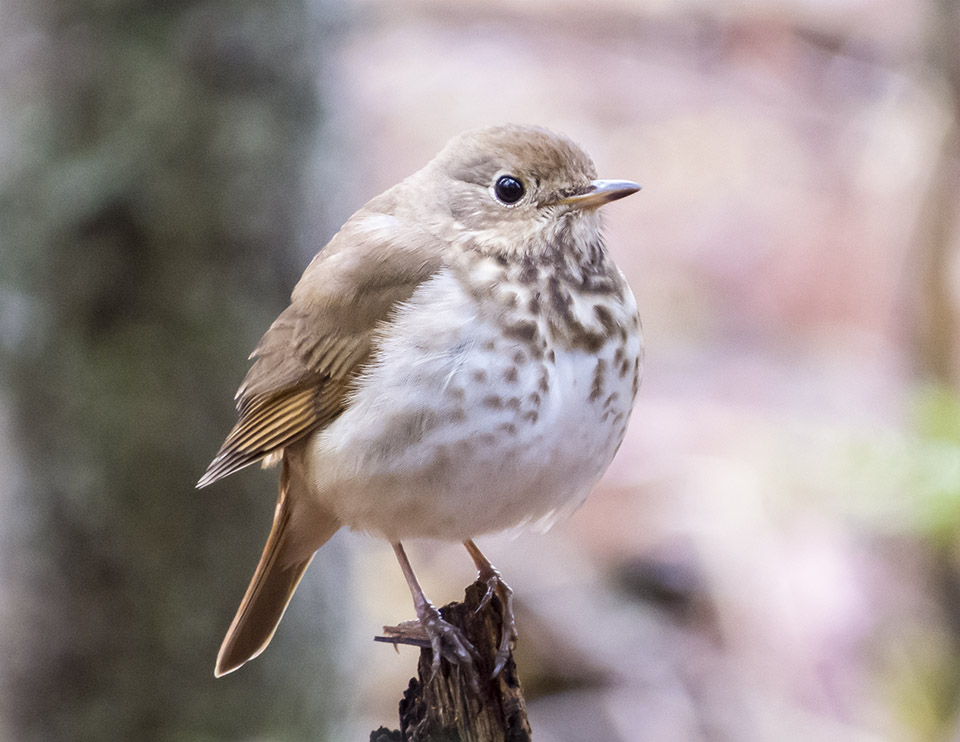
Hermit Thrush: The Hermit Thrush generally puts in an appearance in the Adirondack region by late April. The Hermit Thrush is a short-distance migrant. It winters in the southern US, rarely crossing the Gulf of Mexico. In eastern and central North America, males begin migrating north in March, arriving in our part of the Adirondack Mountains in late April.
The Hermit Thrush breeds in a wide range of forest types, including conifer, northern hardwood, and mixed forest. It is commonly seen in the forest under-story along virtually all the trails covered here. This thrush is even more commonly heard, singing its haunting, evocative song.
Ruby-crowned Kinglet: Another short-distance migrant is the Ruby-crowned Kinglet. This species migrates to the southern and southwestern United States and Mexico for the winter, returning to our part of the Adirondack Mountains by about mid-April. Look for the Ruby-crowned Kinglet in spruce-fir forest and mixed woods. While this tiny bird may be difficult to locate as it flits through the branches, it is easily found by its distinctive, rambling song that builds to an incredibly loud ending.
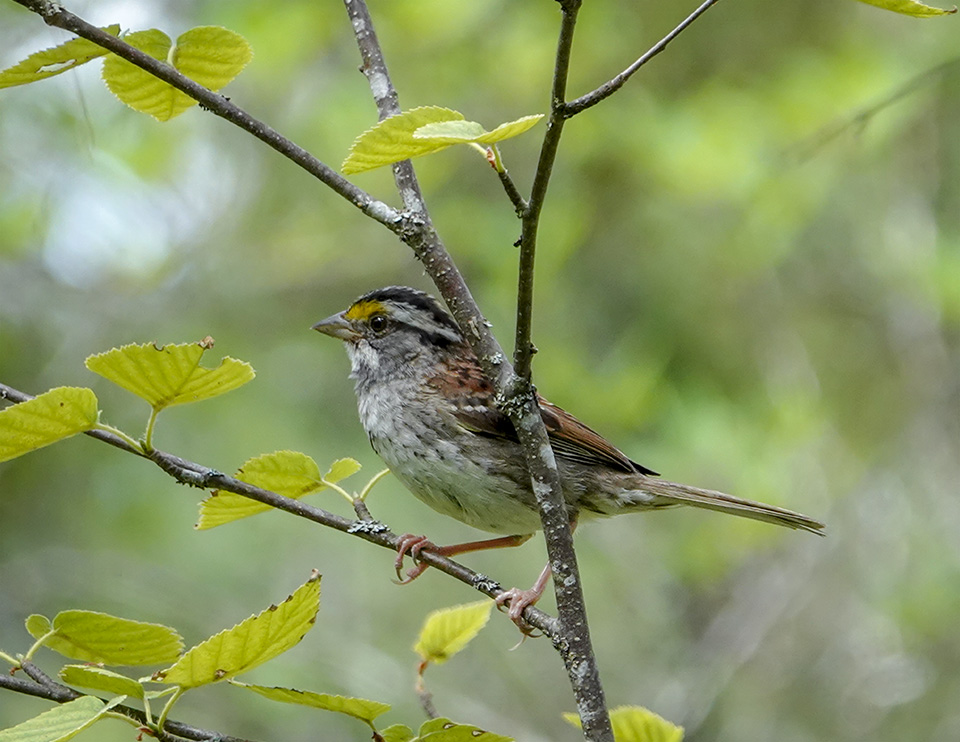
White-throated Sparrow: Another returning summer resident with a distinctive song is the White-throated Sparrow. A short-distance migrant, a few White-throated Sparrows are seen throughout the winter inside the Blue Line. However, most of the White-throated Sparrows we see in spring and summer in the Adirondack Park winter in the southern parts of the US and return to their breeding ranges in northern New York, New England, and Canada when snow melt exposes portions of the forest floor.
White-throated Sparrows are widely-distributed in our area and can be seen and heard along virtually all trails discussed here. Listen for its evocative "oh-sweet-Canada-Canada" as these sparrows forage near the ground and flit about low in the bushes.
Northern Flicker: Although several of our woodpeckers such as the (Downy Woodpecker and Hairy Woodpecker) are year-round residents, others are migratory. The Northern Flicker is an example. Although some flickers appear to spend much of the winter in the warmer Champlain Valley area, most of our flickers usually leave the Adirondack region in the late autumn, and spend the winter in the southeastern US. The peak spring migration is from late March to early April. The flickers arrive in most parts of the Adirondacks by the end of April, eager to find a mate and start a family.
The Northern Flicker's diet consists of insects, primarily ants, which it finds by probing and hammering the soil with its powerful bill and then lapping them up with its long barbed tongue. For that reason, Northern Flickers are usually seen on the ground, in short grass or bare ground, usually near forest edges. If you flush a Northern Flicker from a feeding spot on the ground, you'll see a flash of yellow on the wings and an obvious white rump patch.
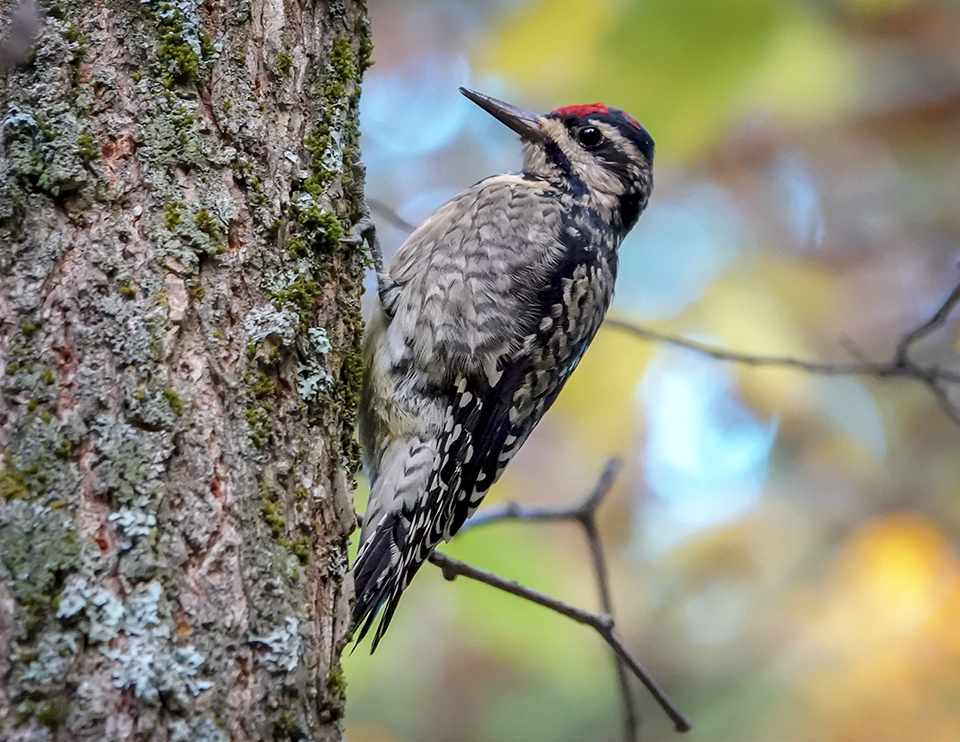
Yellow-bellied Sapsucker: The Yellow-bellied Sapsucker is the only woodpecker in eastern North America that is completely migratory. Although a few individuals remain throughout much of the winter in the southern part of the breeding range, most head farther south, going as far south as Panama. Yellow-bellied Sapsuckers depart their wintering grounds in late March and early April, arriving in our part of the Adirondacks in late April and early May to find partners and rear families. The males arrive first to establish territories. The females arrive about a week later.
Yellow-bellied Sapsuckers are cavity nesters. Yellow-bellied Sapsuckers often return to the breeding site of the previous year, often the very same tree and the same cavity. The male does most of the nest building. The female lays her eggs within a week of nest completion. The incubation period is 10 to 11 days; both parents incubate. Both parents feed the young. The nestlings fledge in 25 to 30 days.
Blue-headed Vireo: Blue-headed Vireos winter along the southeastern seaboard, the Gulf Coast, Mexico, and Central America, leaving their wintering grounds in March and early April and returning to the Adirondack region in early May. Males typically arrive before females.
Nest building begins within two weeks or so after the first arrivals. This species builds its nests in trees. The nest-building process usually takes about a week, resulting in an open cup nest, which is suspended by the rim from a fork or a branch. Both males and female incubate the eggs, which hatch in 13 to 14 days. Both adults participate in feeding the young. The chicks fledge in another 13 to 14 days, but they are totally dependent on their parents for food for about a week after leaving the nest.
Spring & Summer Birds of the Adirondacks:
Wetland Birds
- Alder Flycatcher
- American Bittern
- American Black Duck
- Belted Kingfisher
- Canada Goose
- Common Loon
- Common Merganser
- Great Blue Heron
- Hooded Merganser
- Lincoln's Sparrow
- Mallard
- Merlin
- Olive-sided Flycatcher
- Osprey
- Palm Warbler
- Red-winged Blackbird
- Ring-necked Duck
- Spotted Sandpiper
- Swamp Sparrow
- Wood Duck
- Yellow-bellied Flycatcher
Many of the wetland birds we see in the Adirondack uplands are also migratory, arriving in early spring to breed on lakes, ponds, rivers, and marshes. Most leave for warmer waters further south or in the southern and coastal regions of their breeding range. Some, like the Hooded Merganser and Ring-necked Duck, spend much of the winter in the open waters of Lake Champlain.
American Bittern: The American Bittern spends its winters on coastal plains in the southern US and further south in Mexico and Bermuda. It leaves for its breeding grounds in the northern US and southern Canada in early spring. It usually arrives in the Adirondack region by late April or early May. Listen for its distinctive three syllable "pump-er-lunk" song and watch for it stalking through the vegetation on Heron Marsh or Bloomingdale Bog with its head in the air, imitating a stick.
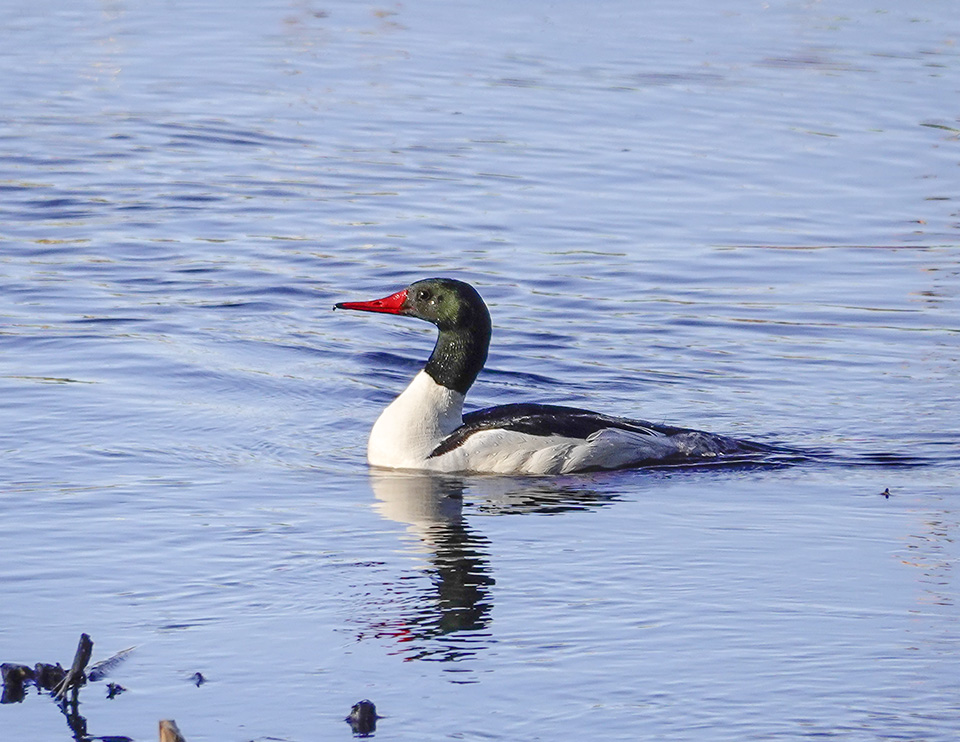
Common Merganser: Late March and April is also the time when the migrating ducks return to much of the Adirondack Park. The Common Merganser spends its winters on large lakes, rivers, and reservoirs in the southern and coastal regions of their breeding range (such as Lake Champlain), and in additional wintering grounds across the northern and western United States. These ducks are among the first ducks to reappear in our part of the Adirondacks. Watch for them in marshes, lakes, and ponds, starting in late March and April as the ice melts and open waters return. The males have white bodies, dark green heads (which appear black in most lights), and a slender, serrated red bill. The females are slate grey with a chestnut head.
Ring-necked Duck: Our Ring-necked Ducks also reappear around this time. Ring-necked Ducks winter inland along the Gulf of Mexico and southern Atlantic coasts. They depart from their wintering sites in February and can usually be found throughout the Adirondacks from mid- to late April on. Look for them resting in the vegetation along the edges and islands of marshes.
Despite the name, the neck rings on the Ring-necked Duck are rarely discernible from a distance, so look for this bird's distinctive, peaked head to help you identify it. Adult males are decked out in gleaming black, gray, and white and have a prominent white ring on the bill. Females are a rich brown and have a gray bill with white and black markings at the tip.
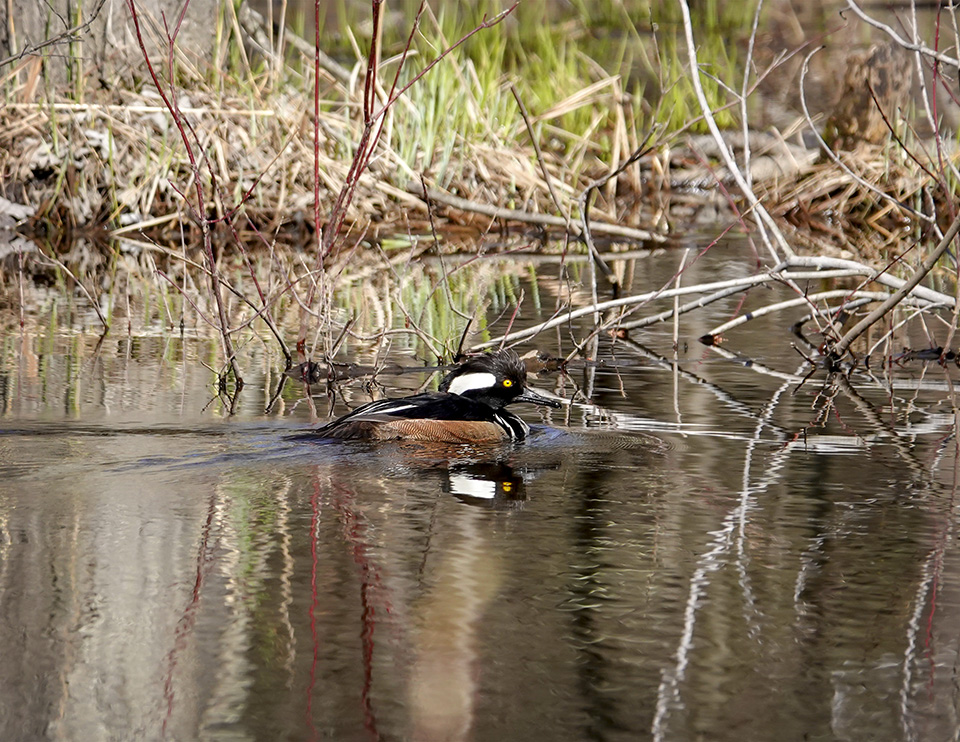
Hooded Merganser: This small diving duck is a resident to medium-distance migrant in the eastern parts of its range. Hooded Mergansers are cavity nesters that prefer live or dead trees in close proximity to water. Female Hooded Mergansers construct and maintain the nests. Only females incubate the eggs, which take about a month to hatch. Male Hooded Mergansers abandon the females soon after incubation begins. The ducklings depart the nest within twenty-four hours of hatching, responding to calls from the female in the water below the nest cavity. Hooded Merganser ducklings are very active and begin feeding themselves from the first day, either diving for food or swimming with their heads under water. They forage primarily on invertebrates.
Swamp Sparrow: Swamp Sparrows winter in the southern US and Mexico. They depart their wintering sites in mid-March to early April, returning to the Adirondack Mountains in late April and early May. Males generally are the first to arrive in breeding areas.
The Swamp Sparrow's preferred breeding habitat includes freshwater cattail marshes, especially marshes with open water, dense low vegetation, and available singing perches. Although the Swamp Sparrow's song is similar to the faster trill of the Chipping Sparrow, if you hear a slow, simple trill from a sparrow-like bird on a marsh, it's probably a Swamp Sparrow. A convenient place to watch and listen for Swamp Sparrows is Heron Marsh, where you can see it perching on cattails near the overlooks on the Heron Marsh Trail and the Barnum Brook Trail. You can also find them along the Bloomingdale Bog Trail, as well as in marshy areas around rivers and streams, such as the Cemetery Road Wetlands between Keene and Keene Valley.
Birds of the Adirondacks: Spring and Fall Transients
Birds of the Adirondacks:
Spring & Fall Transients
As fall and cooler temperatures arrive, the majority of songbirds begin to make their way south. Among the earliest to depart are the warblers, who are heavily dependent on insects and invertebrates for food. Prior to departure, the migrants must ingest large quantities of food to fuel their flight.
In late August and early September, many of the birds we see in the Adirondack Mountains are migrants from Canada, stopping here on their way south. These birds usually travel at night, when it is safer to fly. By morning, they come down to relax and start feeding. To feed and refuel for the next night's journey, these fall migrants join up with groups of resident Black-capped Chickadees, who know the best places to feed.
The migrating birds tend to move in small mixed-species groups, apparently for protection against predators or to help find food. Groups of migrating birds can often be located by listening for the chatter of Black-capped Chickadees, who produce constant chip notes which help keep the small mixed flocks together.
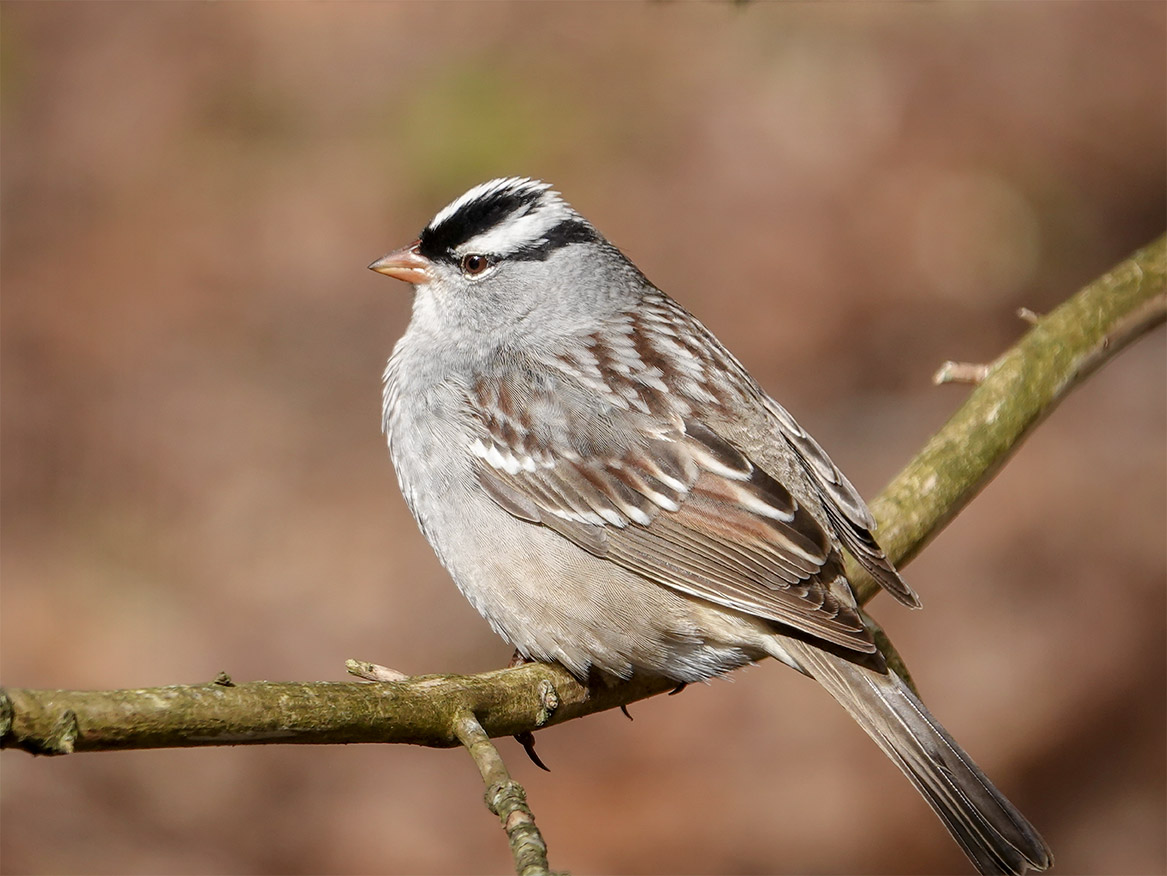
Transients seen in late autumn and early spring include the White-crowned Sparrow. This species winters just south of us in the continental U.S. and Mexico and breeds in open or shrubby habitats in northern Canada and Alaska. These birds pass through our area in early May, traveling north, and then again in late September and early October, traveling south.
White-crowned Sparrows, in contrast to many species, do not migrate as cohesive flocks. Individual birds appear to follow their own flight schedules and do not stay close together except when feeding. White-crowned Sparrows are commonly seen at feeding stations in our area during migration.
Another transient sparrow to look for is the Fox Sparrow, named for its red coloring. This large, stocky sparrow is highly variable. Those that pass through the Adirondacks are "Red" Fox Sparrows, which breed in boreal forests to our north. They are rusty above with some pale gray on the head. They winter south of us, from southeastern Minnesota, southern Wisconsin, central Pennsylvania, southeastern New York, and northern Massachusetts, south to southern Alabama and northern Florida. We see them when they pass through our area in late fall on the way south and then again in early spring on the way north to their breeding grounds in northern Canada.
Birds of the Adirondacks: Winter Birds
Winter Birds of the Adirondacks:
Adirondack Uplands
- American Crow
- American Goldfinch
- American Robin
- American Tree Sparrow
- Barred Owl
- Black-backed Woodpecker
- Black-capped Chickadee
- Blue Jay
- Bohemian Waxwing
- Boreal Chickadee
- Brown Creeper
- Canada Jay
- Cedar Waxwing
- Common Raven
- Common Redpoll
- Dark-eyed Junco
- Downy Woodpecker
- Evening Grosbeak
- Golden-crowned Kinglet
- Great Horned Owl
- Hairy Woodpecker
- Hoary Redpoll
- Mourning Dove
- Northern Cardinal
- Northern Saw-whet Owl
- Northern Shrike
- Pileated Woodpecker
- Pine Grosbeak
- Pine Siskin
- Purple Finch
- Red Crossbill
- Red-breasted Nuthatch
- Red-tailed Hawk
- Ring-necked Pheasant
- Ruffed Grouse
- Sharp-shinned Hawk
- Snow Bunting
- Song Sparrow
- Tufted Titmouse
- White-breasted Nuthatch
- White-winged Crossbill
- Wild Turkey
As winter approaches, only a hardy set of locals remains in most Adirondack locations, dominated by the ubiquitous Black-capped Chickadees, Blue Jays, and Red-breasted Nuthatches. All of the warblers, vireos, and flycatchers and most of the thrushes and ducks have long since departed for winter ranges to the south or the Champlain Valley.
- The list of birds that remain over the harsh winter in the Adirondack Park interior includes, amazingly, the tiny Golden-crowned Kinglet. These active little birds can survive –40 degree nights, sometimes huddling together for warmth. The list also includes the Canada Jay, which (unlike most birds that breed in the Adirondacks) begins its breeding cycle in the cold of winter. Our list of year-round residents also includes some birds, like the Tufted Titmouse and Northern Cardinal, which were once quite rare in the Adirondack Park interior, but have been expanding their range northward as our winters get warmer.
- Some of the birds we see in the winter, such as the Common Redpoll, are not year-round residents, but birds which breed to our north and move south into our area for the winter.
Many of our winter residents are frequent customers at bird feeders. Birds typically seen at feeders during winter include Black-capped Chickadees, Blue Jays, Downy Woodpeckers, American Goldfinches, Hairy Woodpeckers, Dark-eyed Juncos, Red-breasted Nuthatches, Evening Grosbeaks, Pine Siskins, and Purple Finches.
In addition to the hardy birds who spend their winters in the Adirondack interior, a second cast of birding characters can be found in the warmer Champlain Valley – a center for cold-weather birding in the Adirondack Park. Lake Champlain remains open for much of the winter, so it attracts a large number of ducks and other aquatic birds that had abandoned their breeding territories in the Adirondack interior earlier in the fall. A number of raptors also use the lake area as a flyway and remain nearby as long as the weather allows.
Winter Birds of the Adirondacks:
Champlain Valley
- American Black Duck
- American Wigeon
- Bald Eagle
- Barrow's Goldeneye
- Bohemian Waxwing
- Bufflehead
- Canvasback
- Cedar Waxwing
- Common Goldeneye
- Common Merganser
- Common Redpoll
- Cooper's Hawk
- Great Black-backed Gull
- Greater Scaup
- Herring Gull
- Hooded Merganser
- Horned Grebe
- Horned Lark
- Lesser Scaup
- Mallard
- Northern Harrier
- Northern Pintail
- Northern Shrike
- Pine Siskin
- Redhead
- Red-tailed Hawk
- Ring-billed Gull
- Ring-necked Duck
- Rough-legged Hawk
- Sharp-shinned Hawk
- Snow Bunting
- Snowy Owl
Birds of the Paul Smith's College VIC
References
Cornell Lab of Ornithology, Ithaca, New York. All About Birds. Alder Flycatcher, American Bittern, American Black Duck, American Crow, American Goldfinch, American Kestrel, American Redstart, American Robin, Baltimore Oriole, Barn Swallow, Barred Owl, Bay-breasted Warbler, Belted Kingfisher, Bicknell's Thrush, Black-and-white Warbler, Black-backed Woodpecker, Blackburnian Warbler, Black-capped Chickadee, Blackpoll Warbler, Black-throated Blue Warbler, Black-throated Green Warbler, Blue Jay, Blue-headed Vireo, Blue-winged Warbler, Bobolink, Boreal Chickadee, Broad-winged Hawk, Brown Creeper, Brown Thrasher, Bufflehead, Canada Goose, Canada Jay, Canada Warbler, Cape May Warbler, Cedar Waxwing, Chestnut-sided Warbler, Chimney Swift, Chipping Sparrow, Common Grackle, Common Loon, Common Merganser, Common Raven, Common Yellowthroat, Cooper's Hawk, Dark-eyed Junco, Downy Woodpecker, Eastern Bluebird, Eastern Kingbird, Eastern Phoebe, Eastern Wood-Pewee, European Starling, Golden-crowned Kinglet, Gray Catbird, Great Blue Heron, Great Crested Flycatcher, Great Horned Owl, Hairy Woodpecker, Hermit Thrush, Hooded Merganser, Indigo Bunting, Least Flycatcher, Lincoln's Sparrow, Magnolia Warbler, Mallard, Merlin, Mourning Dove, Mourning Warbler, Nashville Warbler, Northern Flicker, Northern Harrier, Northern Parula, Northern Rough-winged Swallow, Northern Waterthrush, Olive-sided Flycatcher, Osprey, Ovenbird, Palm Warbler, Pileated Woodpecker, Pine Grosbeak, Pine Siskin, Pine Warbler, Purple Finch, Red-Breasted Nuthatch, Red-eyed Vireo, Red-shouldered Hawk, Red-tailed Hawk, Red-winged Blackbird, Ring-billed Gull, Ring-necked Duck, Ruby-crowned Kinglet, Ruby-throated Hummingbird, Ruffed Grouse, Savannah Sparrow, Scarlet Tanager, Sharp-shinned Hawk, Song Sparrow, Spotted Sandpiper, Spruce Grouse, Swainson's Thrush, Swamp Sparrow, Tree Swallow, Turkey Vulture, Veery, White-throated Sparrow, White-winged Crossbill, Wild Turkey, Wilson's Snipe, Winter Wren, Wood Duck, Yellow Warbler, Yellow-bellied Flycatcher, Yellow-bellied Sapsucker, Yellow-rumped Warbler. Retrieved 30 January - 2 April 2017.
Cornell Lab of Ornithology. Birds of North America. Subscription Web Site. American Bittern, Blue-headed Vireo, Common Merganser, Common Redpoll, Fox Sparrow, Hermit Thrush, Hooded Merganser, Northern Flicker, Palm Warbler, Ring-necked Duck, Ruby-crowned Kinglet, Swamp Sparrow, White-crowned Sparrow, White-throated Sparrow, Yellow-bellied Sapsucker, Yellow-rumped Warbler. Retrieved 30 January - 2 April 2017.
Cornell Lab of Ornithology, Ithaca, New York. eBird. An Online Database of Bird Distribution and Abundance. Bird Observations (Warren, Hamilton, Essex, Herkimer, Clinton, Franklin). Retrieved 28 December 2021.
Cornell Lab of Ornithology, Ithaca, New York. eBird. An Online Database of Bird Distribution and Abundance. Bird Observations (Hamilton). Retrieved 28 December 2021.
Cornell Lab of Ornithology, Ithaca, New York. eBird. An Online Database of Bird Distribution and Abundance. Bird Observations (Essex). Retrieved 28 December 2021.
Cornell Lab of Ornithology, Ithaca, New York. eBird. An Online Database of Bird Distribution and Abundance. Bird Observations (Hamilton, Essex). Retrieved 28 December 2021.
Kevin J. McGowan and Kimberley Corwin (Eds). The Second Atlas of Breeding Birds in New York State (Cornell University Press, 2008), pp. 466-535, 635 -641.
Douglass H. Morse. American Warblers: An Ecological and Behavioral Perspective (Harvard University Press, 1989).
Alan E. Bessette, William K. Chapman, Warren S. Greene and Douglas R. Pens. Birds of the Adirondacks. A Field Guide (North Country Books, Inc., 1993).
John M.C. Peterson and Gary N. Lee. Adirondack Birding. 60 Great Places to Find Birds (Lost Pond Press, 2008).
Adirondack Park Agency. Checklist of Birds of the Adirondack Park Visitor Interpretive Center at Paul Smiths, NY. Undated.
Alan Belford. Late Fall and Early Winter Birding in the Champlain Valley! Retrieved 28 December 2021.
Alan Belford. Early Spring Birding in the Champlain Valley. Retrieved 28 December 2021.
Alan Belford. Winter Birds of the Champlain Valley. Retrieved 28 December 2021.
Alan Belford. Counting Birds in the Champlain Valley. Retrieved 28 December 2021.
Alan Belford. Super March Birding in the Lake Champlain Region! Retrieved 28 December 2021.
Alan Belford. Great Winter Birding in the Lake Champlain Region. Retrieved 28 December 2021.
Alan Belford. Brrrrding in the New Year! Retrieved 28 December 2021.
Alan Belford. Ducks and Raptors along the Southern ADK Coast. Retrieved 28 December 2021.
Alan Belford. Great Ducks And Raptors Around Crown Point. Retrieved 28 December 2021.
Alan Belford. Raptors and Owls in the Lake Champlain Region! Retrieved 28 December 2021.
Alan Belford. Excellent Birding in the Lake Champlain Region! Retrieved 28 December 2021.
